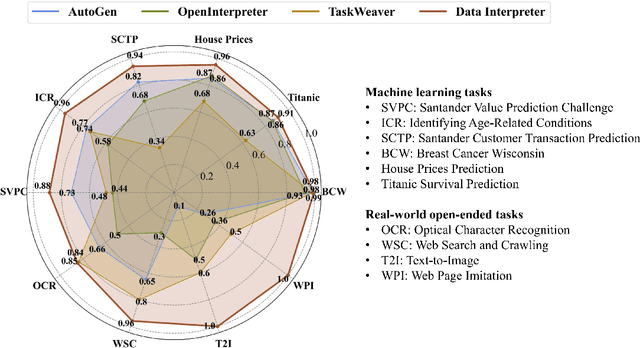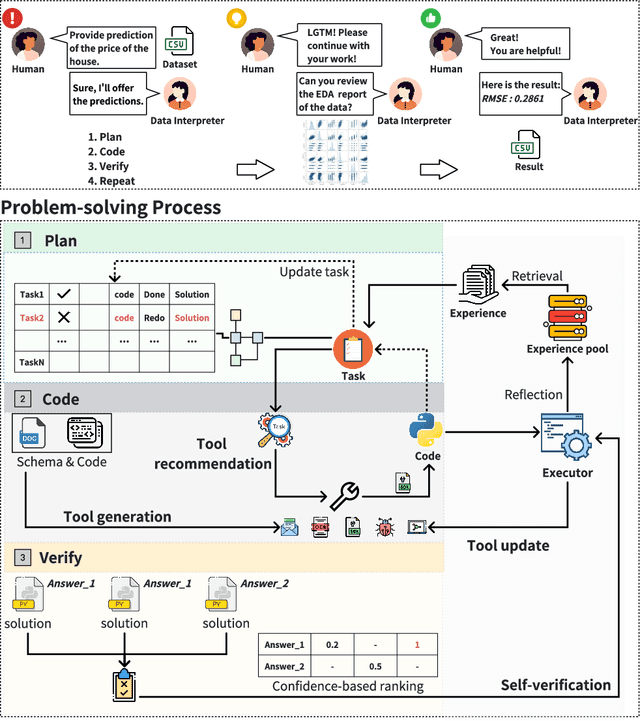Binhao Wu
EmbSpatial-Bench: Benchmarking Spatial Understanding for Embodied Tasks with Large Vision-Language Models
Jun 09, 2024Abstract:The recent rapid development of Large Vision-Language Models (LVLMs) has indicated their potential for embodied tasks.However, the critical skill of spatial understanding in embodied environments has not been thoroughly evaluated, leaving the gap between current LVLMs and qualified embodied intelligence unknown. Therefore, we construct EmbSpatial-Bench, a benchmark for evaluating embodied spatial understanding of LVLMs.The benchmark is automatically derived from embodied scenes and covers 6 spatial relationships from an egocentric perspective.Experiments expose the insufficient capacity of current LVLMs (even GPT-4V). We further present EmbSpatial-SFT, an instruction-tuning dataset designed to improve LVLMs' embodied spatial understanding.
DELAN: Dual-Level Alignment for Vision-and-Language Navigation by Cross-Modal Contrastive Learning
Apr 02, 2024Abstract:Vision-and-Language navigation (VLN) requires an agent to navigate in unseen environment by following natural language instruction. For task completion, the agent needs to align and integrate various navigation modalities, including instruction, observation and navigation history. Existing works primarily concentrate on cross-modal attention at the fusion stage to achieve this objective. Nevertheless, modality features generated by disparate uni-encoders reside in their own spaces, leading to a decline in the quality of cross-modal fusion and decision. To address this problem, we propose a Dual-levEL AligNment (DELAN) framework by cross-modal contrastive learning. This framework is designed to align various navigation-related modalities before fusion, thereby enhancing cross-modal interaction and action decision-making. Specifically, we divide the pre-fusion alignment into dual levels: instruction-history level and landmark-observation level according to their semantic correlations. We also reconstruct a dual-level instruction for adaptation to the dual-level alignment. As the training signals for pre-fusion alignment are extremely limited, self-supervised contrastive learning strategies are employed to enforce the matching between different modalities. Our approach seamlessly integrates with the majority of existing models, resulting in improved navigation performance on various VLN benchmarks, including R2R, R4R, RxR and CVDN.
Data Interpreter: An LLM Agent For Data Science
Mar 12, 2024



Abstract:Large Language Model (LLM)-based agents have demonstrated remarkable effectiveness. However, their performance can be compromised in data science scenarios that require real-time data adjustment, expertise in optimization due to complex dependencies among various tasks, and the ability to identify logical errors for precise reasoning. In this study, we introduce the Data Interpreter, a solution designed to solve with code that emphasizes three pivotal techniques to augment problem-solving in data science: 1) dynamic planning with hierarchical graph structures for real-time data adaptability;2) tool integration dynamically to enhance code proficiency during execution, enriching the requisite expertise;3) logical inconsistency identification in feedback, and efficiency enhancement through experience recording. We evaluate the Data Interpreter on various data science and real-world tasks. Compared to open-source baselines, it demonstrated superior performance, exhibiting significant improvements in machine learning tasks, increasing from 0.86 to 0.95. Additionally, it showed a 26% increase in the MATH dataset and a remarkable 112% improvement in open-ended tasks. The solution will be released at https://github.com/geekan/MetaGPT.
ReForm-Eval: Evaluating Large Vision Language Models via Unified Re-Formulation of Task-Oriented Benchmarks
Oct 17, 2023



Abstract:Recent years have witnessed remarkable progress in the development of large vision-language models (LVLMs). Benefiting from the strong language backbones and efficient cross-modal alignment strategies, LVLMs exhibit surprising capabilities to perceive visual signals and perform visually grounded reasoning. However, the capabilities of LVLMs have not been comprehensively and quantitatively evaluate. Most existing multi-modal benchmarks require task-oriented input-output formats, posing great challenges to automatically assess the free-form text output of LVLMs. To effectively leverage the annotations available in existing benchmarks and reduce the manual effort required for constructing new benchmarks, we propose to re-formulate existing benchmarks into unified LVLM-compatible formats. Through systematic data collection and reformulation, we present the ReForm-Eval benchmark, offering substantial data for evaluating various capabilities of LVLMs. Based on ReForm-Eval, we conduct extensive experiments, thoroughly analyze the strengths and weaknesses of existing LVLMs, and identify the underlying factors. Our benchmark and evaluation framework will be open-sourced as a cornerstone for advancing the development of LVLMs.
 Add to Chrome
Add to Chrome Add to Firefox
Add to Firefox Add to Edge
Add to Edge